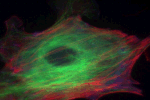Laser-induced microexplosions: ultrafast physics with clinical applications,
at
20th Annual International Conference of the IEEE Engineering in Medicine and Biology Society (Hong Kong),
Thursday, October 29, 1998:
Nanosurgery with femtosecond lasers
Subcellular surgery and nanoneurosurgery,
at
A Year of Physics Colloquium, North Carolina A&T State University (Greensboro, NC),
Thursday, November 10, 2005:
Subcellular surgery and nanosurgery,
at
Physics Colloquium, Amherst College (Amherst, MA),
Thursday, October 4, 2007:
Subcellular surgery and nanosurgery,
at
Physics Colloquium, University of Notre Dame (Notre Dame, IN),
Wednesday, May 12, 2010:
Sub-cellular nanosurgery in live cells using ultrashort laser pulses,
at
Photonics West (San Jose, CA),
Friday, January 21, 2005:
Using short bursts of photons to manipulate biological matter at the nanoscale,
at
Winter Colloquium on the Physics of Quantum Electronics (Snowbird, UT),
Friday, January 5, 2007:
Subcellular surgery and nanosurgery,
at
Physics Colloquium, Australian National University (Canberra, Australia),
Tuesday, March 24, 2009:
Plasmonic cell transfection using micropyramids,
at
SPIE Photonics West 2014 (San Francisco, CA),
Sunday, February 2, 2014:
. 2015. “Plasmonic Tipless Pyramid Arrays for Cell Poration.” Nanoletters, 15, Pp. 4461–4466. Publisher's VersionAbstract
. 2005. “Nanosurgery in live cells using ultrashort laser pulses.” In . SPIE Photonics West. Publisher's VersionAbstract
. 2012. “Nucleation and Transport Organize Microtubules in Metaphase Spindles.” Cell, 149(3):554-64, Pp. –. Publisher's VersionAbstract
. 2006. “Viscoelastic retraction of single living stress fibers and its impact on cell shape, cytoskeletal organization, and extracellular matrix mechanics.” Biophys. J., 90, Pp. 3762–3773. Publisher's VersionAbstract
. 2009. “Surgical applications of femtosecond lasers.” J. Biophoton., 2, Pp. 557–572. Publisher's VersionAbstract
 The detailed architecture of spindle microtubules, involved in cell division, was revealed using femtosecond laser nanosurgery. This work was performed in collaboration with the Needleman group (results published in Cell).
The detailed architecture of spindle microtubules, involved in cell division, was revealed using femtosecond laser nanosurgery. This work was performed in collaboration with the Needleman group (results published in Cell).